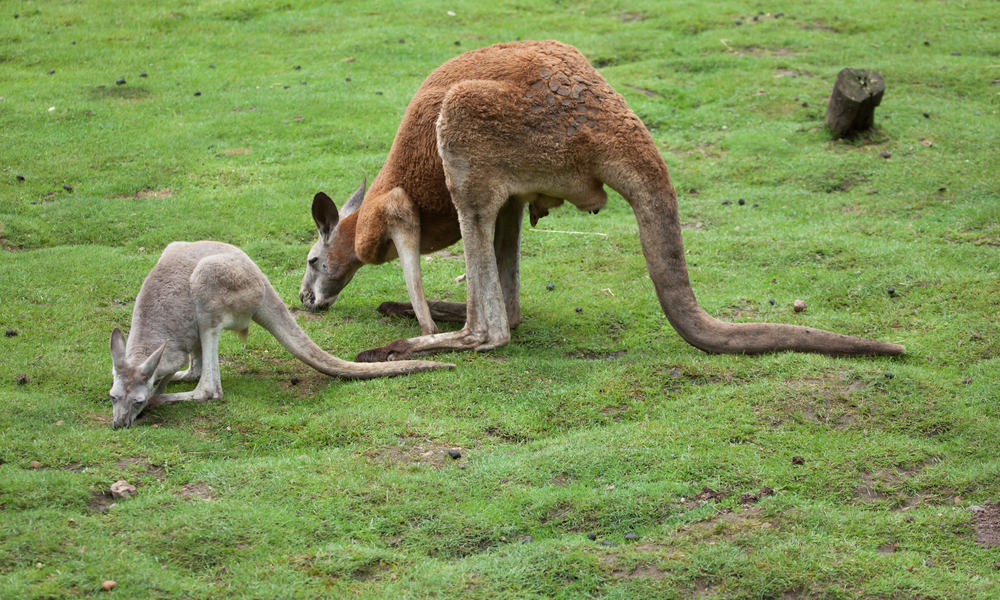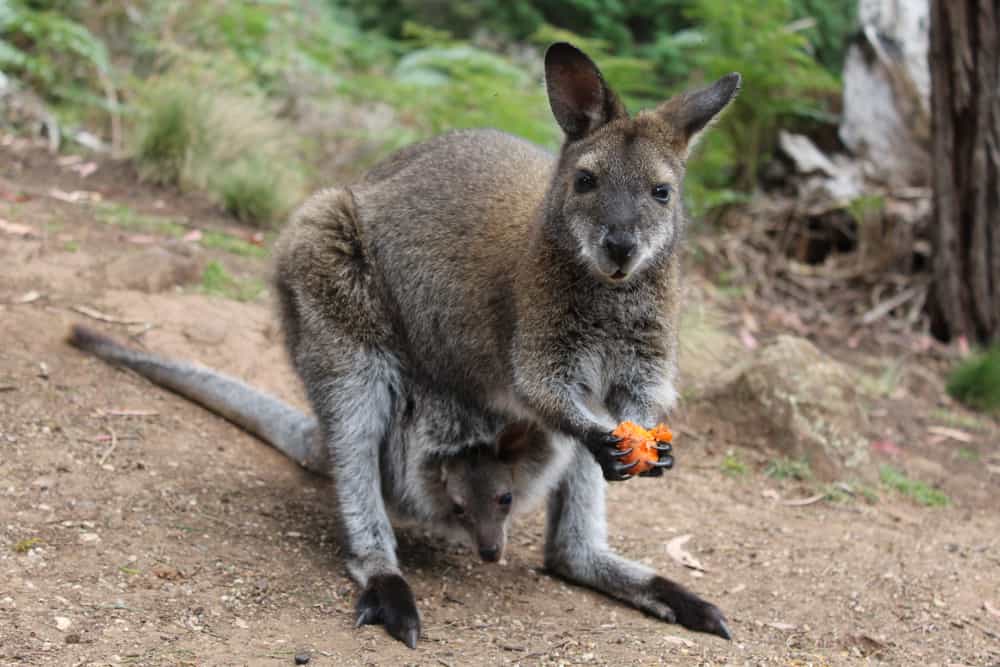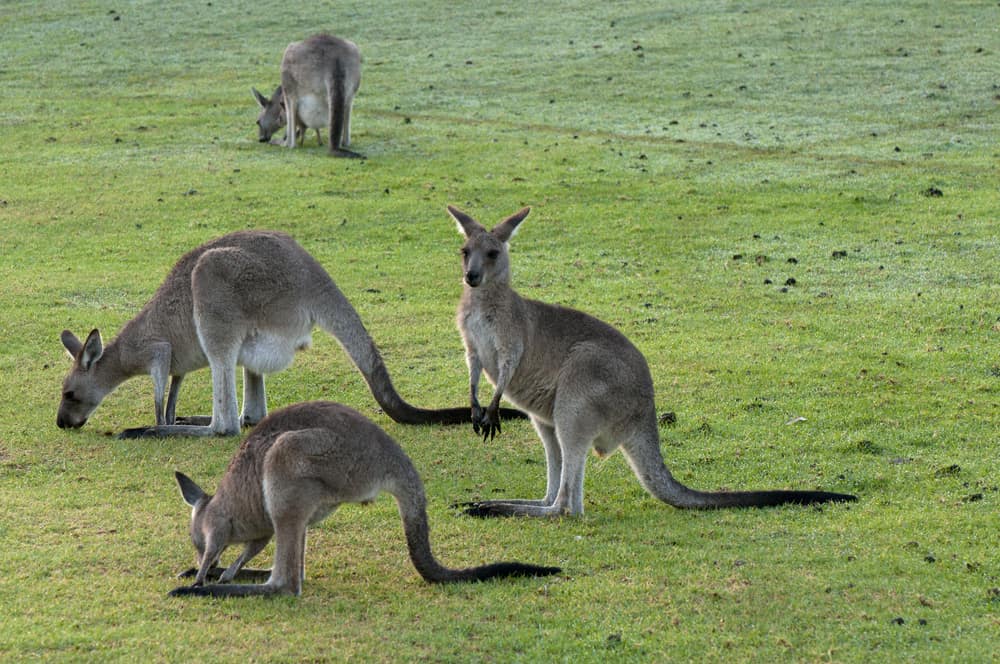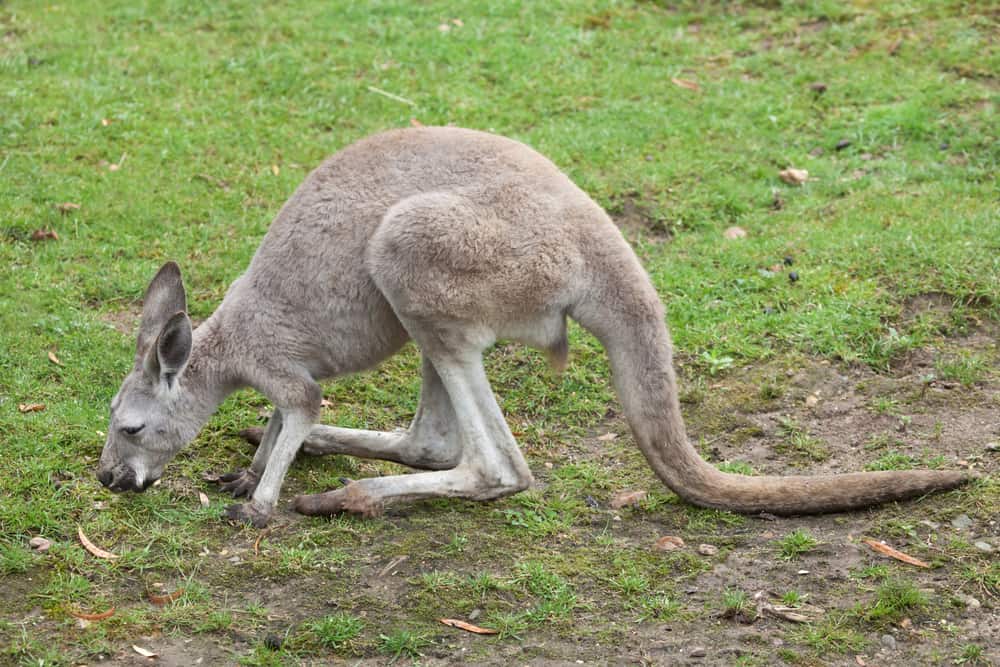Everyone has heard about Kangaroos and their pouches. Approximately 44 million Kangaroos live in Australia, and they are one of the most recognizable symbols of this continent. All existing species are herbivores, but a few are opportunistic omnivores. It seems that there is not any mystery about what do Kangaroos eat. Let’s see if that’s the case.
What Do Kangaroos Eat in the Wild

The term Kangaroo encompasses 54 members of the Macropodidae (a big foot) family that includes:
- Kangaroos
- Wallabies
- Pademelons
- Wallaroos
Feeding that depends on the environment

All these pouched marsupials live in Australia and nearby islands, and their feeding habits directly depend on the habitat where they live.
On the ground
Animals that feed on the ground typically graze plants of the open plains. They swallow the whole grass while eating and then bring it back from a chambered stomach to the mouth for thorough chewing. After re-swallowing, food goes to another stomach part for final digestion.
On the trees
Some Kangaroo types spend most of their time on trees. These opportunistic omnivores consume tree bark, leaves, flowers, fruit, seeds, and sap they find up there. However, they often eat moss, eggs, and young birds but sometimes swallow even small animals passing by.
In the garden
A few species enjoy eating fruit and veggies from gardens. Plus, they consider roses a yummy dessert. On the other hand, these Kangaroos hate aromatic plants like lavender, rosemary, and eucalyptus.
In captivity
You can barely find pet Kangaroos, but you can see them in the Zoos. Animals that live in captivity usually eat:
- Properly formulated pellets
- Alfalfa hay
- Vegetables like carrots, lettuce, and broccoli
- Fruit like bananas, grapes, and apples
- Extra greens, including romaine and dandelion leaves
- Treats like corn, raisins, and sweet potato
Never feed a Kangaroo with human food since it causes a nutritional imbalance in their bodies. As a result, such an animal can become obese and prone to various diseases.
Feeding that depends on the species
Kangaroos’ diet also depends on the species and their size. Let’s talk about specific diets for four large ground species:
Red Kangaroo
The Red (Giant) Kangaroo is the largest:
- Extant marsupial worldwide
- Terrestrial mammal native to Australia
- Kangaroo on the Australian continent
An average animal is 6 to 7 feet (1.8 – 2.1 m) tall and weighs about 60 to 200 pounds (27 – 91 kg).
These social creatures live in mobs (groups) that include two to a few hundred animals and choose open grasslands and deserts for their habitats. They usually eat at night and prefer:
- Green grass
- Flowering plants
- Herbage
- Shrubs
Interestingly, they can live without water for months thanks to utilizing the moisture from food. The species’ average lifespan is 20 to 23 years.
Kangaroo type |
||||
| Scientific classification | Great Kangaroo | Tree-Kangaroo | Rat-Kangaroo | Musky rat-Kangaroo |
| Kingdom | Animalia | Animalia | Animalia | Animalia |
| Subkingdom | Bilateria | Bilateria | Bilateria | Bilateria |
| Infrakingdom | Deuterostomia | Deuterostomia | Deuterostomia | Deuterostomia |
| Phylum | Chordata | Chordata | Chordata | Chordata |
| Subphylum | Vertebrata | Vertebrata | Vertebrata | Vertebrata |
| Infraphylum | Gnathostomata | Gnathostomata | Gnathostomata | Gnathostomata |
| Superclass | Tetrapoda | Tetrapoda | Tetrapoda | Tetrapoda |
| Class | Mammalia | Mammalia | Mammalia | Mammalia |
| Subclass | Theria | Theria | Theria | Theria |
| Infraclass | Metatheria | Metatheria | Metatheria | Metatheria |
| Order | Diprotodontia | Diprotodontia | Diprotodontia | Diprotodontia |
| Suborder | Macropodiformes | Macropodiformes | Macropodiformes | Macropodiformes |
| Family | Macropodidae | Macropodidae | Potoridae | Hypsiprymnodontidae |
| Subfamily | Macropodinae | Macropodinae | / | / |
| Genus | Macropus | Dendrolagus | 3 | Hypsiprymnodon |
| Species | 4 | 12 | 6 | Hypsiprymnodon moschatus |
Eastern grey Kangaroo
The Eastern Grey Kangaroo (Forester Kangaroo, Gigantic Large-foot, Great Grey Kangaroo) is about 5.5 to 6.5 feet (1.7 – 2 m) high, making it only a bit smaller than the Red species. Besides, they are among Australia’s heaviest native land mammals that weigh 150 to 200 pounds (68 – 91 kg).
The primary food for these nocturnal animals gathering in large mobs is:
- Grass
- Herbs
- Green shoots
- Leaves
- Low shrubs occasionally
- Fungi when necessary
The Eastern Grey Kangaroo is the Australian most populated Kangaroo species that run with a speed of 40 mph (64.5 km/h). Its average lifespan ranges from 7 to 20 years.
Western Grey Kangaroos
The Western Grey Kangaroo (Sooty Kangaroo, Black-faced Kangaroo, Mallee Kangaroo) is the smallest Kangaroo species that live in southwestern Australia. They are about 4.3 feet (1.3 m) tall and 120 pounds (54.5 kg) heavy and live approximately 9 to 13 years.
These Kangaroos are considered the most vocal species. Their males produce a distinctive curry-like smell and enjoy boxing in their free time. They need water at least once in two days and graze at night and early morning. Their favorite food includes:
- Native pasture grass
- Exotic pasture grass
- Flowers like lilies, chenopods, and forbs
- Crops, particularly lupin crops
- Succulents
- Leafy shrubs
- Low tree leaves
This animal is highly tolerant to the plant toxin fluoroacetate from endemic legumes.
Antilopine Kangaroo
The Antilopine Kangaroo (Antilopine Wallaby, Antilopine Wallaroo) is 4 feet (1.2 m) tall animal that typically reaches a weight of 110 pounds (50 kg). They got the name after the coat that reminded to antelopes fur.
You can see these herbivorous enjoy grazing in the morning and evening, and their preferable food is:
- Short, green grass-like tussock grass
- Long grass portions left after burning in bush fires
Mobs spend almost 45% of the day looking for food. Since they can extracts water from food, they can withstand long without additional fluid. Most individuals live about 16 years.
Other Kangaroo species
Unlike four large, ground-dwelling Kangaroo species that are strict herbivores or folivores that enjoy a specific leaf diet, tree-dwelling species are omnivores. They usually eat plants but can consume meat when necessary, and their diet includes:
- Leaves and flowers
- Tree bark
- Fruit
- Veggies like carrots
- Seeds
- Sap
- Bird eggs and hatchlings
- Small animals
Australians usually consider these species pests.
Kangaroos are mostly active from dusk to dawn when looking for food. They sometimes dig holes deep 40 inches (1 m) to find water when necessary.
5 Facts About Kangaroos

The Kangaroos got their name after the term Gangurru. Kokoimudji (the Guuga Yimithirr people) who lived in Far North Queensland gave this name to Eastern Grey Kangaroos. Over time, people have used it for all known jumping marsupials.
Aboriginal people consider these animals significant for their culture and spiritual life. Plus, they hunt them for:
- Meat as a staple protein source
- Pelts necessary for rugs and clothing items
- Skin for making water bags
Habitat
Besides Zoos, Kangaroos live on the Australian continent, Tasmania, and New Guinea. You can find them in:
- Savannahs
- Deserts
- Wooded forests
- Grassy plains
- Bushland and scrublands
Red Kangaroos live across Australia, while Eastern Greys prefer the open woodlands and forested coastal areas from Cape York to Tasmania.
Western Greys enjoy denser vegetation they can find in open forests and woodlands from Western Australia to Victoria. Finally, Antilopine Kangaroos choose northern monsoonal tropical eucalyptus woodlands for living.
Moving
Kangaroos don’t walk or swim like most other mammals but hop. Their hop can reach an impressive 26 feet (8 m) while running at 37 mph (59.5 km/h). The muscular tails play a crucial role in balancing while hopping, but these animals can also use them for swimming.
Interestingly, the tail disables them to move backward. That is why Australians put a Kangaroo to their coat of arms as a symbol of national progress.
Social living
These animals live in mobs (groups) that include:
- Boomer (male, buck)
- Flyer (female, doe)
- Joey (baby Kangaroo)
You can hear alarmed Kangaroos hissing and growling while stomping with one foot on the ground. Flyers click when communicating with offspring, but the weirdest sound is chuckling that boomers use during courtship.
Joeys
The most unusual part of a Kangaroo body is s forward-opening pouch necessary for carrying the joeys where they suckle and develop.
The pregnancy lasts for 21 to 38 days, and a flyer typically gives birth to one 0.2 to 0.9 inches (5 to 23 mm) long baby. The gestation period lasts for 120 to 450 days when the joey becomes capable of independent living.
Females raise only one joey annually but can carry extra embryos in a pouch. They are in a so-called embryonic diapause (dormant state) until the joey leaves the pouch.
Plus, they can feed and look after the joey that can live out of the pouch. It is fascinating that the flyer has four teats, and each of them provides milk with different nutritional content adapted to each joey age.
Females will become fully mature after 14 to 20 months, while males need 2 to 4 years to reach maturity.
Endangered species
Most Kangaroo species, including four great ones, are widespread, but the IUCN Red List of Threatened Species put Black Wallaroo on a list of the near-threatened animals. Plus, the other 16 Rat-Kangaroo and Tree-Kangaroo species are:
- Threatened or near threatened
- Vulnerable or endangered
- Critically endangered
The Nullarbor dwarf bettong is an extinct species.
Summary
Kangaroos are the biggest marsupials on the earth. Over 40 million of these animals live in Australia, but you can also find them in Tasmania and New Guinea. People admire the pouches necessary to grow their joeys and carry them safely throughout the desert. Kangaroo females are unique for their ability to look after three joeys of different ages at once.
